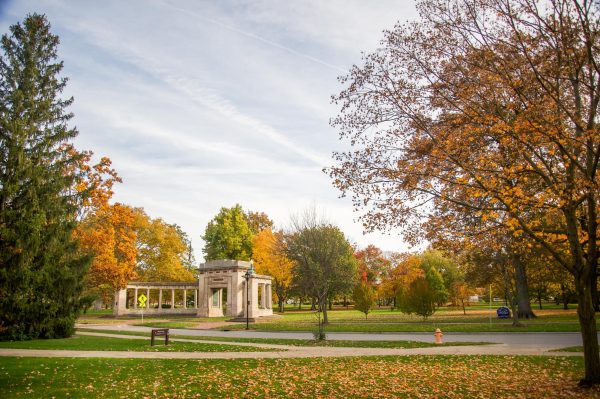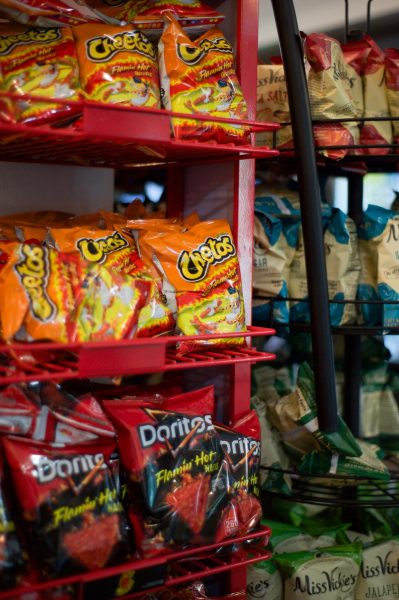Increasing Medical Marijuana Accessibility Would Help Fight Opioid Epidemic
President Trump gave a speech on March 29 in Richfield, Ohio, that, among other topics, tapped into a conversation which hits home for many Ohioans: opioid addiction. As of December 2016, Ohio’s opioid-related death rate of 39 percent was second only to that of West Virginia. Out of the 4,329 general drug overdose deaths in Ohio in 2016, 83 percent of these deaths were opioid-related. Despite numerous attempts at lowering this death rate through policy, nothing seems to work. Trump’s audience, mainly union engineers and maintenance workers, and the setting, an industrial barn, were carefully chosen; his words, less so. One topic that he failed to mention — as most legislators have failed to as well — is the potential of marijuana to decrease the rates of opioid–related deaths.
Trump has continuously promised to attack the opioid epidemic through policy. On March 2, he commented that “the administration is going to be rolling out policy over the next three weeks, and it will be very, very strong,” adding that he spoke “with [Attorney General] Jeff [Sessions] about bringing a lawsuit against some of these opioid companies.” Other policy enactments include Congress allocating several billion dollars to the federal budget to combat the opioid epidemic, promise from the Department of Justice to help states in suing corrupt opioid companies and suppliers, and the Centers for Medicare and Medicaid Services allowing states to apply for waivers to use. Trump also donated his third-quarter salary to the Department of Health and Human Services specifically for use in the fight against opioid addiction.
However, his recent comments seem to contradict these previous actions, all of which were undertaken in late 2017 and early January 2018. In early March, President Trump asserted that “the only way to solve the drug problem is through toughness.” By “toughness,” Trump was chiefly referring to establishing minimum sentences and — in some cases — giving the death penalty to drug dealers who knowingly deal illicit opioids. He also argued that other foreign countries like Singapore have lower rates of drug addiction because they deal out harsher sentences to drug dealers. He emphasized that in the U.S., individuals can be sentenced to death for the murder of one person, while drug dealers are treated much less harshly even though the drugs they sell potentially factor in the deaths of many people. Trump also plans to cut the number of prescribed opioids in half within three years, though he has not specified how exactly he intends to achieve this goal. And, of course, as the requisite cherry atop the Trumpian sundae, he has again argued that we must build a wall to stop illicit drugs from crossing the southern border, to which he also just deployed National Guard troops this week.
Although Trump’s move to increase funding to fight opioids, the waiver for Medicare and Medicaid, and the help from the Justice Department in suing opioid companies were certainly steps in the right direction, his militaristic crackdown on drug dealers and border relations are grossly misguided at best. As long as there is a demand for opioids, drug dealers will continue to develop new, more dangerous, and more easily transported illicit drugs, and no amount of regulations, tough talk, or military action will change that.
This is clearly seen through the crackdown on heroin; when legislators nationwide attempted to further regulate heroin — including the targeting of dealers — the amount of heroin-related deaths decreased, but those related to fentanyl skyrocketed. The correlation is no mystery. Fentanyl is 50 to 100 times more potent and much cheaper than heroin. It also has legal uses within the medical field, making it much easier to obtain than heroin. There are few differences in the manufacturing processes for illicit and medicinal fentanyl, so it is much easier to transport, access, and hide. Fentanyl is also often distributed through the mail, not across the southern border like how heroin typically is. Building a wall would therefore not hinder some major sources of illicit sales, notably those sold online through China — a country identified by U.S. officials as the major source of opioid sales in the U.S. — which travel through the mail.
The proposed solutions tumbling around in the national discourse have proved unsuccessful in the past — attempts at rehabilitation reform, parole reform, suing pharmaceutical companies and corrupt physicians, and increasing the availability of life-saving emergency drugs for overdose situations have all fallen flat. However, one possibility that has not been receiving enough consideration is the legalization of marijuana. Results from a 1999–2010 study on U.S. Medicare, which mostly covers people over the age of 65, showed that states with legalized medicinal marijuana had drastically less overdose death rates. Those statistics found that the states that legalized medical marijuana in 2010 all saw a decrease of about 1,700 opioid-related deaths that year. According to another study, hospitalization rates for opioid painkiller dependence and abuse dropped 23 percent on average in states after marijuana was permitted for medicinal purposes, and hospitalization rates for opioid overdoses dropped an average of 13 percent.
While medical marijuana may be legal in Ohio, it is largely inaccessible. There are 88 counties in Ohio, but only 40 dispensaries were approved by Ohio’s pharmacy board. In a State of Ohio Medical Board survey, only 7.5 percent of the total physicians who responded said that they were likely to recommend medicinal marijuana and that they worked within a medical system that would allow them to do so. The law also does not allow home-grown marijuana for those who are approved to use it medically. Finally, there is a provision of the law that requires patients to report whether they have previously been arrested or charged while attempting to access medicinal marijuana.
The demand for accessible marijuana in Ohio is quite high. Medicinal marijuana advocate Don Keeney said that people “always say this is a young people’s item,” but that he has had “people [sign] on petitions from [ages] 80 to 18 and all in between.” Many people can greatly benefit from the effects of medical marijuana and recognize the positive role it could play in the fight against opioids. Regardless, officials are ignoring the best interests of Ohioans. Medicinal marijuana has technically been legal in Ohio since Sept. 8, 2016, yet we have not seen its potential to positively affect the epidemic because of its inaccessibility. In a state ravaged by opioids, this is simply unacceptable. The federal and state governments should be doing everything in their power to save the lives that are at risk. There is no excuse for medicinal marijuana to not be readily available to those who need it given its proven efficacy. Anyone who is interested in slowing the progression of this epidemic, including federal and state legislators and President Trump, must act on the very obvious fact before them: that marijuana can only help in the fight against opioids.




